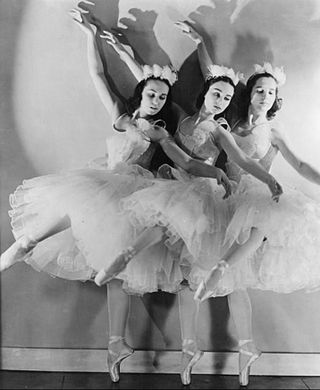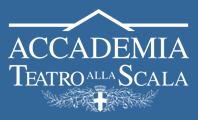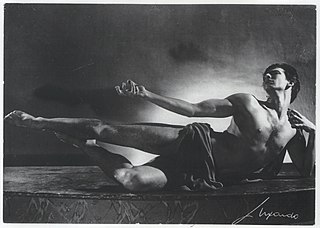Early career
Born in Milan in 1940, Amodio trained at the ballet school of the Teatro alla Scala, whose ranks he joined immediately. While there, he performed in productions by Léonide Massine (Il cappello a tre punte, Capriccio spagnolo, Fantasmi al Grand Hotel), George Balanchine (Sinfonia in Do, I quattro temperamenti), and Petit (Le quattro stagioni, Le jeune homme et la mort, La chambre, Le loup).
At the age of 22, he left the company of the Teatro alla Scala to begin his career as a choreographer and free-lancing dancer, which led him to pivotal collaborations with Hermes Pan, who chose him as lead in the Italian TV production Studio Uno , and with Aurel Milloss at the Teatro dell'Opera di Roma.
He frequently returned to the Teatro alla Scala, where he performed with Carla Fracci in productions of Il gabbiano and Pelléas et Mélisande . In 1973, he was featured with Fracci in a documentary that was screened on the RAI television network in Italy. [1] Excerpts from Prokofiev's Romeo & Juliet , Offenbach's Cancan and Tchaikovsky's Sleeping Beauty were shown.
In 1975, Amodio signed his version of the Après-midi d'un phaune for the Spoleto Festival dei Due Mondi, which was then offered in reprise at the Teatro alla Scala with Luciana Savignano and scenes by Giacomo Manzù. In the same year and for this latter company, he also created Ricercare a nove movimenti.
Aterballetto
After appearing in two movies by Liliana Cavani, The Night Porter (Il portiere di notte) in 1974, [2] and Beyond Good and Evil (Al di là del bene e del male) in 1977, [3] in 1979 he was appointed artistic director of Aterballetto, a modern ballet company created by A.T.E.R. (Associazione Teatri dell'Emilia Romagna) and based in Reggio Emilia. He directed the company until 1996. At Aterballetto, his work was considered experimental and said to be promoting new forms that were widely perceived "as the first examples of a national [Italian] form of choreography. [4]
Having consciously decided to select 20 dancers who would be able to tackle any style of music and ballet techniques, Amodio created for them a vast repertoire that paired his own creations with those of the Pantheon of choreographers. Under his guidance, Aterballetto produced Amodio's own The Nutcracker , Naturale, Mazzapegul, Un petit train de plaisir, Coppélia , and Cabiria, while ambitiously taking on the work of masters such as Glen Tetley, Alvin Ailey, Lucinda Childs, George Balanchine, Antony Tudor, Kenneth MacMillan, José Limón, Hans van Manen, Léonide Massine, David Parsons, and Maurice Béjart. [5]
During his tenure as Artistic Director for Aterballetto, Amodio strengthened his liaisons with noted composers and musicians, many of whom contributed original music for his creations; among them, Luciano Berio, Sylvano Bussotti, Aldo Bennici, Azio Corghi, Giuseppe Calì, Jan Garbarek, Naná Vasconcelos, and Edoardo Bennato.
Anxious to incorporate other media in his work, he elicited the artistic input of high-caliber costume and set designers (such as Emanuele Luzzati, M. Antonietta Gambaro, Luisa Spinatelli, and Maurizio Millenotti) while painters and sculptors produced unique artwork (among them, Mario Ceroli, Piero Dorazio, Lucio Del Pezzo, and Claudio Parmiggiani).
The Strange Case of Dr Jekyll and Mr Hyde was his last work created for Aterballetto, where Mauro Bigonzetti succeed him as Artistic Director.

Alessandra Ferri OMRI is an Italian prima ballerina. She danced with the Royal Ballet (1980–1984), American Ballet Theatre (1985–2007) and La Scala Theatre Ballet (1992–2007) and as an international guest artist, before temporally retiring on 10 August 2007, aged 44, then returning in 2013. She was eventually granted the rank of prima ballerina assoluta.
Mauro Bigonzetti is an Italian ballet dancer and choreographer. He trained at the ballet school of Teatro dell'Opera di Roma and entered their company in 1979.

Fabio Grossi is a retired Italian dancer and ballet teacher.

The company Ballets Russes de Monte-Carlo was formed in 1932 after the death of Sergei Diaghilev and the demise of Ballets Russes. Its director was Wassily de Basil, and its artistic director was René Blum. They fell out in 1936 and the company split. The part which de Basil retained went through two name changes before becoming the Original Ballet Russe. Blum founded Les Ballets de Monte Carlo, which changed its name to Ballet Russe de Monte Carlo when Léonide Massine became artistic director in 1938. It operated under this name until it disbanded some 20 years later.

Carolina "Carla" Fracci was an Italian prima ballerina, actress and ballet director. Considered one of the greatest ballerinas of the 20th century, she was a leading dancer of La Scala Theatre Ballet in Milan, then worked freelance with international companies including the Royal Ballet, London, Stuttgart Ballet, Royal Swedish Ballet and American Ballet Theatre. Fracci is known for her interpretation of leading characters in several Romantic ballets, such as La Sylphide, Giselle, Swan Lake, and Romeo and Juliet. She also performed in ballets such as Nijinsky and Complete Bell Telephone Hour Performances: Erik Bruhn 1961–1967. She danced with partners including Erik Bruhn, Rudolf Nureyev and Mikhail Baryshnikov. Later, she directed several ballet companies in Italy, including at the Teatro San Carlo in Naples and the Teatro dell'Opera di Roma in Rome.

La Scala Theatre Ballet School is one of the leading classical ballet schools in the world and is the associate school of La Scala Theatre Ballet, an international ballet company based at La Scala in Milan, Italy. The school forms part of the theatre's Academy for Performing Arts.

Igor Yebra Iglesias is a Spanish freelance ballet dancer.
Wayne Eagling is a Canadian ballet dancer, now retired. After more than twenty years as a popular member of The Royal Ballet in London, he became well known as an international choreographer and company director.
The La Scala Theatre Ballet is the resident classical ballet company at La Scala in Milan, Italy. One of the oldest and most renowned ballet companies in the world, the company pre-dates the theatre, but was officially founded at the inauguration of La Scala in 1778. Many leading dancers have performed with the company, including Mara Galeazzi, Alessandra Ferri, Viviana Durante, Roberto Bolle and Carla Fracci. The official associate school of the company is the La Scala Theatre Ballet School, a constituent of the La Scala Theatre Academy.
Jacopo Godani is an Italian dancer-choreographer who directs Dresden Frankfurt Dance Company
Giuseppe Picone is an Italian principal ballet dancer, choreographer, artistic director of the Ballet Company of Teatro San Carlo in Naples.
José Carlos Martínez is a Spanish dancer and choreographer. He was a danseur étoile of the Paris Opera Ballet and artistic director of the Spanish National Dance Company. He became the director of dance at Paris Opera Ballet in December 2022.

Guido Lauri was an Italian dancer, actor, choreographer, ballet master, company director.
Carlo Di Lanno is an Italian ballet dancer. He is a former Principal Dancer with the San Francisco Ballet and Dresden Semperoper Ballett. He trained and graduated at Accademia Teatro alla Scala, and danced with Teatro alla Scala and Staatsballett Berlin.

Francesco Ventriglia is an Italian ballet dancer, choreographer and artistic director. In 2010 he was appointed as Europe's youngest artistic director by the Florence Opera House at the age of 32, where he held the role as artistic director and principal choreographer for Maggio Danza until 2013. In 2014, he was named the artistic director of the Royal New Zealand Ballet until June 2017, and from January 2018, as adjunct artistic director of the National Ballet of Uruguay, Ballet Nacional Sodre alongside Igor Yebra. Ventriglia is also a choreographer of classical and contemporary ballet, having works performed internationally by companies such as the La Scala Ballet, Arena di Verona, Bolshoi Theatre, the Mariinsky Ballet, Grande Theatre du Geneve, Royal New Zealand Ballet, Ballet Nacional Sodre and at the Venice Biannale.
Stefano La Colla is an Italian tenor who has given recitals and performed in opera internationally.

Raimonda Gaetani is an Italian stage set and costume designer.

Marco Filibeck is an Italian lighting designer.
Lorca Massine is an American choreographer and dancer, born in New York on July 25, 1944, to Russian immigrant Léonide Massine, an accomplished choreographer and dancer. He studied dance with his father, Victor Gsovsky, Asaf Messerer and Anatole Wilzac. Over his career, he has collaborated with world-acclaimed choreographers such as Balanchine, Béjart, as well as his father.
Elisabetta Terabust was an Italian ballerina and company director. She trained at the Teatro dell'Opera di Roma and worked for the London Festival Ballet and the Ballet National de Marseille. Terabust served as director of the Teatro dell'Opera di Roma, La Scala, MaggioDanza of the Maggio Musicale Fiorentino and of the Corps de ballet at the Teatro di San Carlo at various points between 1990 and 2009. The primary ballet rehearsal room at the Teatro dell'Opera Di Roma Dancing School was renamed for her.









